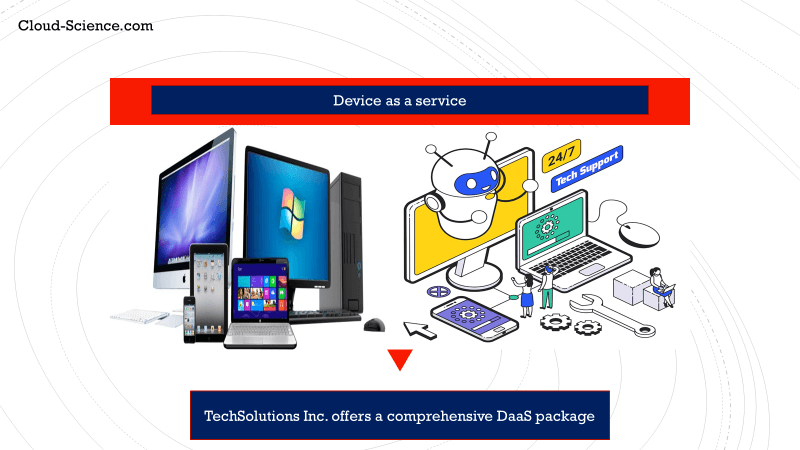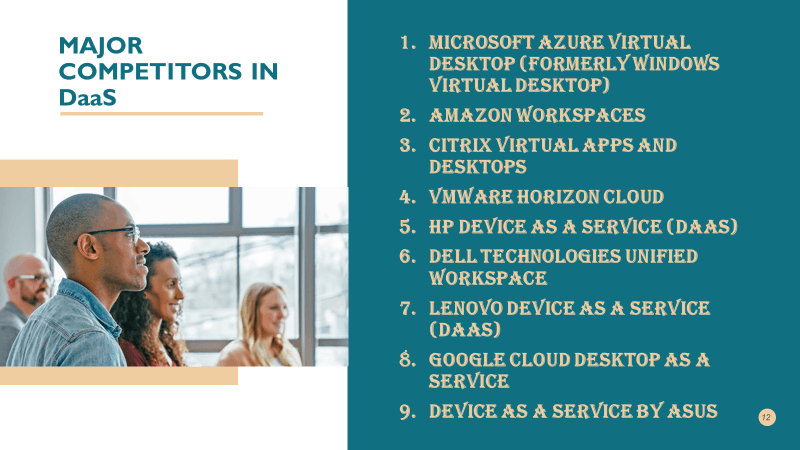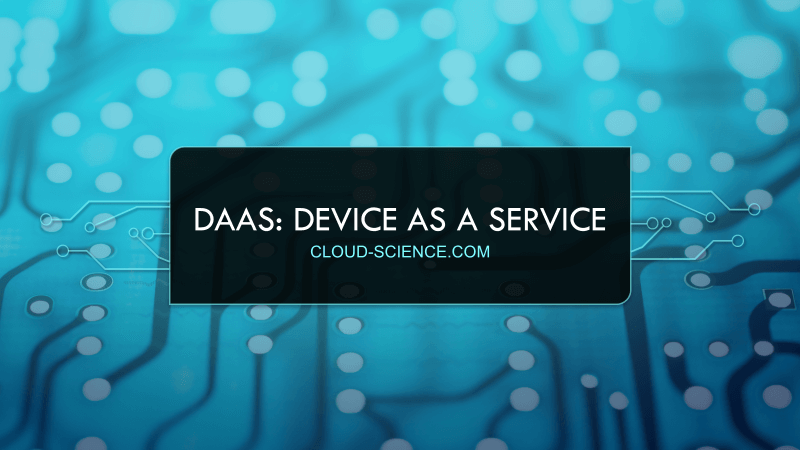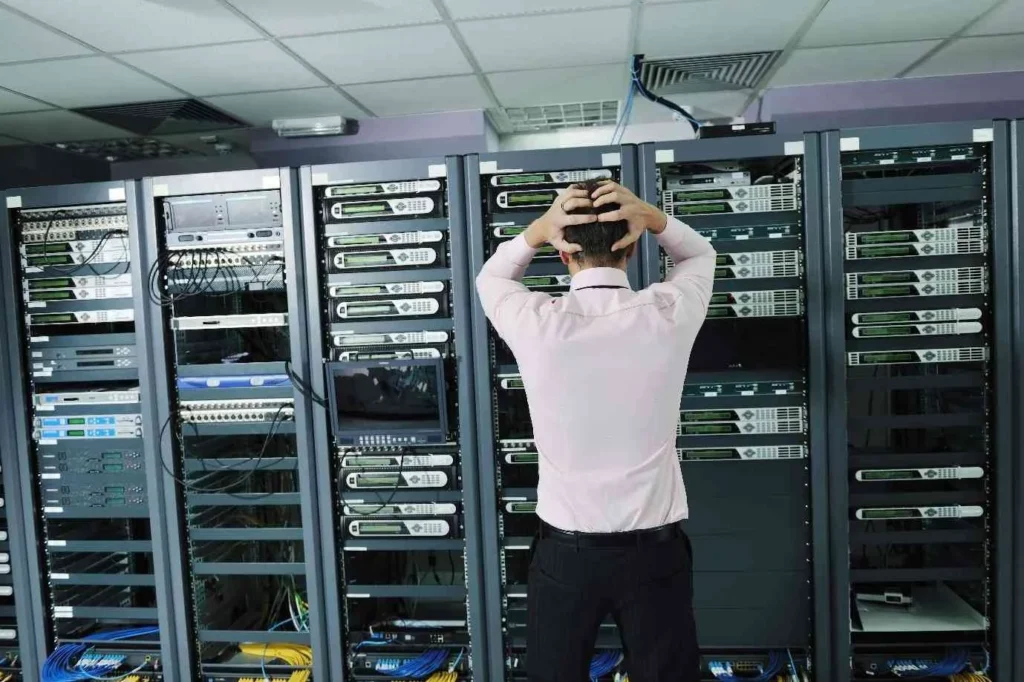DaaS allows a company to cut back on its internal IT staff, since the hardware, software, and devices are managed offsite by another company.
Some people might even consider how they can enhance their savings in today’s ever transforming and rather difficult business setting.
A booming growth of various technologies came in phonemically in 2020 which was brought about by the covid 19 pandemic, in particular accelerating the adoption of digitalization and working from home.
DaaS is an easily emerging model in Information technology across vast organizations within the short time. Otherwise referred to as Donna Rental Service, it provides a standard solution for similar companies like yours and helps scale down expenses by the provision of flexible consumption of services such as is DaaS.
Device as a Service (DaaS) Overview:
Device as a Service (DaaS) is a unique service model which offers a device requirement solution for both individuals and businesses. DaaS bundles this product when in traditional buying when laptops, desktops, tablets or smart phones are purchased one by one.
This includes not just hardware but also includes software and security, maintenance and help desk support. Modern devices have become more commonplace in organizations and in order to possess them without a considerable expenditure and the difficulties that accompany Conventional procurement processes, through a subscription model, the requirement is easily met.
DaaS enhances all the activities related to procurement, execution and management of the devices allowing organizations to concentrate on the primary and the important activities.
Device as a Service (DaaS) vs Desktop as a Service (DaaS)?
At times it’s really hard to follow and when searching information on DaaS services people get lost because of reference on two services which are using the same abbreviation Device as a Service DaaS Desktop as a Service DaaS. Which one is why it is possible to begin clarifying the differences which are there between them.
In Device-as–a-Service, companies provide end-users with tangible devices based upon the principles of a lease.
Unlike this, DaaS does not mean the renting of application only. By utilizing a subscription method like Device as a Service, organizations are able to trim down their IT costs compared to a capital expense model, improve operational efficiency and be more flexible within the current and future business environment.
In Desktop-as-a-Service is a cloud computing In the desktop-as-a-service model, companies gain access to hardware without the burdens of purchasing, configuring, or overseeing it
Consequently, in order to stay competitive and satisfy the expectations as well as the needs of the business and consumer market, it is imperative for PC makers and hardware suppliers to adopt DaaS.
To take the discussion further, it is also imperative to address what DaaS (Device as a Service) is: how it works, what its advantages are, and in general, who the alluded DaaS providers are.
How does DaaS Work? "Illustrative Example"

Let’s more elaborate on how to use Device as a Service for your business.
Let us see how Device as a Service (DaaS) would possibly be implemented in a fictional Company XYZ Corp.
XYZ Corp is medium-sized company employing 200 employees. Instead of purchasing and managing their fleet of laptops for their employees, they decide to go for Device as a Service option from a third party, TechSolutions Inc.
TechSolutions Inc. has in its arsenal a DaaS offering and invokes all of its components in respect of contracts both signed by the client and in-house:
Hardware: TechSolutions Inc. supplies several laptops for employees at XYZ Corporation as per the various requirements and sizes of the Corporation. They collaborate with XYZ Corp to make decisions on the most suitable mobile devices to be used.
Deployment: After deciding on what devices to procure, XYZ Corp places an order with TechSolutions Inc. who purchases the laptops on its behalf, sets them up based on the company’s guidelines and delivers them to the door steps of the employees. They take care of every possible preparation and installations, enabling the efficiency of out-of-the-box apparatus each time.
Management: Centralized administration of devices is any other essential aspect of the DaaS solution, and TechSolutions Inc. employs different management tools to allow XYZ Corp’s IT administrators to manage and monitor devices when they are not present physically. They include setting security policies, updating software, and troubleshooting as they never need to touch each equipment anymore.
Support: Employees of XYZ Corp may contact TechSolutions Inc. for Technical Services support on a continuous basis. In the event that any member of staff is using a hardware unit or application and experiences a hardware failure or software snag, they can call up the support team at TechSolutions to assist which brings down the idle time and disruption to productivity.
Subscription: XYZ Corp does not purchase any hardware but only pays for the DaaS service each user on a monthly basis. This cost consists of hardware costs, deployment, management tools, support offered, within the same package, other services such as software subscriptions or accessories may be offered in the package.
Scalability: As the XYZ Corp wishes to expand or shift its employees and their devices with time, it prefers changing the device as a service subscription with TechSolutions Inc. Subscription can be increased or reduced in accordance to their changing demand requirements hence being cost effective and flexible
With the help of Device as a Service offered by TechSolutions Inc., XYZ Corp can relieve herself of the stress that comes with controlling IT hardware yet assuring that employees are provided with pertinent devices and accompanying operational support to enable productivity.
Why is DaaS Becoming Famous?
Let have a good look at what are the factors that contribute to the growing popularity of Device as a Service (DaaS)
1. Cost Efficiency
The use of DaaS diminishes the requirement of high costs in purchasing hardware support and software programs. In contrast, an enterprise makes a monthly subscription payment which facilitates the planning of expenses and alleviates the pressure resulting from upgrades of the technical equipment.
2. Simplified Management
DaaS Providers manage device provisioning, deployment, updates, and maintenance, which enable the IT teams to focus on productivity rather than mundane activities. The Device as a Service model enables the third-party vendor to take care of the entire lifecycle of hardware devices, which is aimed at lowering the customer’s operational handling. This makes the process of purchasing, setting up, maintaining and supporting simpler so that the enterprise can achieve its main goals.
DaaS Providers allow remote device management by use of helpful tools designed for device management. Device management becomes cost effective as many operations including software updating and troubleshooting are factored in and this makes device application and security better.
3. Scalability
DaaS allows organizations to expand or contract its device infrastructure as the organization’s dimensions vary towards the organizations’ device usage. This flexibility is perfect for businesses that are expanding or those with varying market demand.
4. Access to Latest Technology
In essence, DaaS makes it possible to communicate with ever-evolving hardware and software components by periodic refresh of hardware and software contents. Consequently there is no need for frequent changes or capital investment by organizations as they have the latest devices and software at their disposal.
By adopting DaaS, the organizations will be ahead of the competition knowing that they will benefit from the current high technology which improves productivity and competitiveness.
5. Enhanced Security
The majority of DaaS providers usually include security measures in their packages to ensure that the customers’ devices and information are protected against advanced threats. With Device as a Service (DaaS), there is an added level of security through various measures that are put in place by the vendor.
DaaS is sometimes accompanied with rather extreme protections of data and devices, including encryption, detection of potential or actual threats, and remote data and software erasure tools. Furthermore, DaaS providers are not complacent and always watch out for new threats, applying new security formulae and patches as and when necessary.
By delegating the burden of security management to professionals, companies can achieve complete security for their devices and information, which helps in minimizing the risks posed by any potential security threats.
6. User-Centric Approach
DaaS offers improved end-user experience in terms of integration of the right device at the right time owing to the way devices are provided. DaaS is user-centered and takes into consideration the needs and preferences of its users.
Since this DaaS provides a range of devices and services that users can choose from according to their needs, it increases the productivity and satisfaction of the users.
Also, DaaS enables users to receive their devices after selection as well as help from the organization, thus making efficient use of devices an easy task. This focus on the user benefits enhances the experience of employees and helps the organization achieve the success that it is striving for.
7. Reduced IT Burden
Pushing device management into the arms of DaaS providers helps relieve the internal IT teams enabling them to prioritize strategy over device upkeep. DaaS outsourcing includes the acquisition, management and support of devices making device procurement less of a concern for a company.
This decreases the need for internal workers to be contracted to addresses issues above and beyond installing equipment such as repairing equipment, updating programs and resolving problems. DaaS allows companies to outsource such administrative matters to the providers instead of relying on their inhouse teams for information technology support. They can look for strategic areas of the business and support their achievement.
It helps eliminate too much administration and enhances efficiency of business since DaaS does the heavy lift of nonstrategic/administrative work of the IT departments.
8. Predictable Expenses
Allowing the consumption of DaaS on a subscription basis leads to budgeting advantages due to control over the expenses. A subscription based model allows for a consistent recurring cost, as organizations will pay a pre agreed rate per user or per device.
This removes the requirement for heavy initial capital outlay on equipment and provides certainty on the budgeting aspect by stretching expenses in the course of time. DaaS increases the accuracy of planning for various IT activities by eliminating the unforeseen costs that come with the purchase, upkeep and support of various IT setups.
This further allows improving onsite financial management, resource allocation by reducing the costs associated with occupying more than a single workspace for one activity by DaaS in one flat rate payment which enhances business overall stability and success.
9. Remote Work Enablement
DaaS makes it easier for employees to work outside the office by giving them virtual desktops and office devices that can be located anywhere in the world connected to the internet. As a result there is enhanced cooperation and productivity irrespective of location.
Employees are able to work in different devices and use applications that they are permitted to work in while the management and security of the data is retained and monitored centrally. With DaaS, organizations are able to respond to changes in work settings without compromising on the advantages of flexibility and mobility.
DaaS is particularly effective in promoting telecommuting as it simplifies the process of providing required devices and support to employees which can be done at any location.
10. Comprehensive Support
In many DaaS service packages, technical support, troubleshooting and repairing are part of the deal in such a way that they help reduce the helplessness of a user losing business hours and the healthy use of the gadgets. DaaS undertakes a wide range or holds the responsibility of solving the management of devices from their acquisition to their use.
This involves hardware and software improvements and maintenance, issues and problems resolution, and support, which reduce downtimes and interruptions on productivity. When maximized, these support services prevent IT systems from being compromised and thus allowing the organization to pursue its goals.
What are the Drawbacks of DaaS?
It’s imperative for organizations to assess both advantages and downsides of the device-as-a-service model. While the device-as-a-service model has several advantages, there are several conflicts that need to be identified and dealt with:
Ownership Ambiguity: Organizations continue to pay for a device but at no time ever own any part of it, hence the issue of returns on investment in the long run emerges.
Total Cost of Ownership TCO: In some cases, organizations may fail to attain the TCO as vendors may commonly assure. It’s unfortunate that clients may later come to appreciate such burdening costs.
Privacy Concerns: Letting vendors deal with the servicing and repair of the devices may be problematic as it could deal with privacy aspects as confidential data may be lost in the course of this.
Regulatory Limitations: There are areas that are regulated and because of that, these factors may stifle the implementation of a device-as-a-service model as they require some level of adherence.
Limited Device Selection: Device selection could be another limitation: organizations could find themselves in a position where providers only provide certain types of devices thereby limiting freedom of choice, and adaptability.
Device as a Service (DaaS) vs. Traditional Device Procurement
In a traditional device procurement model, the possessions of the devices and control over the devices is dominant, on the other hand, DaaS offers a different structure in which the control and management of the devices including the entire life cycle is outsourced which ensures flexibility, scaling and predictability. previously is the brief description of DaaS device Procurement vs traditional device procurement.
| Aspect | Device as a Service (DaaS) | Traditional Procurement & Management |
|---|---|---|
| Acquisition Model | Subscription-based model | Upfront purchasing of devices |
| Cost Structure | Predictable monthly fees | Significant upfront costs |
| Device Refresh | Regular hardware and software upgrades | New purchases for upgrades |
| Management | Provider handles deployment, updates, etc. | Internal IT teams responsible |
| Scalability | Easily scale up or down | Challenges in scaling due to upfront costs |
| Flexibility | Suited for remote work environments | May require extra effort for remote work |
| Security | Often includes built-in security solutions | Organizations manage security measures |
| IT Burden | Relieves IT burden | Requires internal IT management |
How To Select Device as a Service (DaaS)?

Before selecting a Device as a Service (DaaS) provider, it’s essential to evaluate various key factors:
| Aspect | Considerations |
|---|---|
| Assessment of Business Needs | Understand your organisation's specific device requirements, including types and quantity, and identify any additional services or features needed. |
| Comparison of Service Offerings | Analyze the offerings of different DaaS providers, considering device options, software bundles, management services, support, and pricing structures. |
| Scalability | Ensure the chosen DaaS provider can accommodate your organisation's growth and scale the service accordingly as your needs evolve. |
| Security Measures | Evaluate the security measures implemented by the DaaS provider, such as data encryption, endpoint security, compliance certifications, and privacy policies, to safeguard sensitive information. |
| Reliability and Performance | Assess the provider's reliability, uptime track record, performance benchmarks, and adherence to service level agreements (SLAs) for consistent and high-quality service delivery. |
| Cost Analysis | Compare the total cost of ownership (TCO) of DaaS offerings, including subscription fees, setup costs, device refresh charges, and support fees. |
| Vendor Reputation | Research the reputation and experience of potential DaaS providers through customer reviews, industry recognition, and client references to ensure reliability and customer satisfaction. |
| Flexibility and Customization Options | Look for DaaS providers offering flexibility and customization to tailor the service to your organization's unique needs rather than a one-size-fits-all approach. |
| Integration Compatibility | Assess how well the DaaS solution integrates with your existing IT infrastructure, including compatibility with current software applications, data migration capabilities, and interoperability with other systems. |
| Contract Terms and Exit Strategy | Review contract terms, including subscription duration, renewal terms, termination clauses, and data ownership rights, ensuring alignment with your organization's needs. Consider the exit strategy in case of a transition from the DaaS provider. |
What are the best DaaS providers in the market?
After getting an understanding of which aspect you need to check before selecting a DaaS service let’s see some of the best options available for a DaaS in the market.

The Final Verdict: Device as a Service (DaaS)
To conclude, Device as a Service (DaaS) is a great option for companies that want to simplify their processes while improving their adaptability and controlling expenses. DaaS is the attraction of the dollars in operations – instead of a company investing large dollars upfront into hardware, they will also be able to enjoy the benefits in DaaS where the cost is spread through fixed payments taken every month.
Of all advantages, this feature can be especially beneficial in and managing operating budgets. Furthermore, the advantage of this system is in its capacity to meet different needs when it comes to the deployment of devices without additional costs associated with purchasing and disposing of devices.
This can also be redeemed for health benefits as organizations do not have to own devices that will become obsolete due aftermarket practices employed by DaaS providers who change out hardware every so often.
Further too, typically ordinary DaaS contracts would also come with some device management support services like maintenance, upgrades, and support which allows businesses to spare themselves of providing device management services to customers and avoid distractions to their core business. In short, Device as a Service helps organizations to upgrade their technology, reduce uncertainties, and make the most out of their resources and time in a fast developing technological environment.
Frequently Asked Questions: DaaS.
Device as a Service (DaaS) is a subscription-based model where businesses lease hardware devices such as computers, laptops, smartphones, and tablets for a specified period, typically every month, instead of purchasing them outright.
In DaaS, businesses enter into agreements with service providers to lease hardware devices for a set duration. Businesses pay a recurring fee for the use of these devices, which often includes services like maintenance, support, and upgrades.
DaaS can benefit businesses of various sizes and industries, especially those looking to optimise IT operations, control costs, and stay competitive in the digital landscape. It's particularly advantageous for businesses with fluctuating device needs or those seeking to modernize their IT infrastructure.
DaaS agreements can encompass a wide range of hardware devices, including computers, laptops, tablets, smartphones, printers, and more, depending on the specific needs of the business.
At the end of a DaaS agreement, businesses typically can renew the agreement, upgrade to newer devices, or return the devices to the service provider. Some agreements may also offer the option to purchase the devices at a discounted rate.
DaaS providers typically include security measures as part of their services, such as data encryption, regular security updates, and compliance with industry regulations. However, businesses should ensure they understand the security protocols in place and choose reputable providers to mitigate risks.
Yes, DaaS can be particularly beneficial for remote work setups, as it provides businesses with the flexibility to easily deploy and manage devices for remote employees. Additionally, DaaS agreements often include remote support services to address technical issues efficiently.



